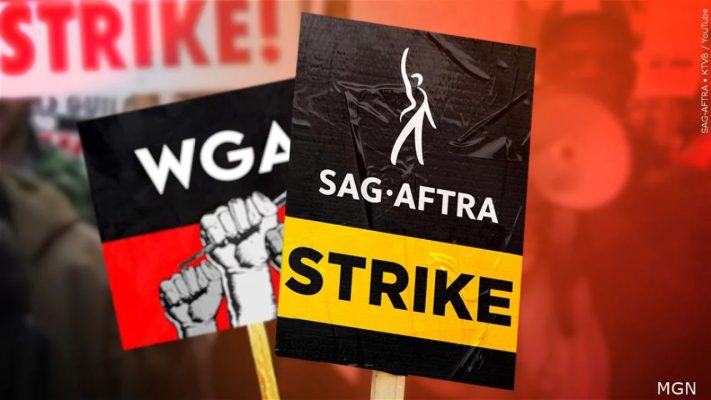
Let’s delve into a game-changer in the entertainment industry’s labor dynamics – the SAG-AFTRA Video Game Strike. This headline-grabbing event marks a turning point in negotiations involving the Screen Actors Guild-American Federation of Television and Radio Artists (SAG-AFTRA) and major players in the video game industry. At its core, this strike tackles critical issues, including wage increases and safeguards against the encroachment of artificial intelligence, among others.
Here, on this platform, we aim to unravel the nuances of the SAG-AFTRA Video Game Strike and invite you to be a part of the conversation at nowviralvideo.com. The ripple effects of this strike extend far and wide, making it crucial to grasp its context and anticipate its consequences.
Contents
1. Introducing the SAG-AFTRA Video Game Strike
The SAG-AFTRA Video Game Strike marks a pivotal moment in the ongoing negotiations involving the highly regarded Screen Actors Guild-American Federation of Television and Radio Artists (SAG-AFTRA) and key players within the video game industry. This labor strike, which falls under the purview of the Interactive Media Agreement, holds the potential to profoundly impact the entire landscape of entertainment. Fundamentally, it resonates as a passionate plea for fairness and equity within an industry that has been radically transformed by rapid technological advancements. Voice actors and performance capture artists find themselves facing unprecedented challenges, largely due to the emergence of artificial intelligence (AI).
In essence, this comprehensive overview seeks to offer a thorough exploration of the intricate issues entwined with the SAG-AFTRA Video Game Strike. By delving into the historical context, key concerns, and the union’s perspective, our aim is to provide a nuanced comprehension of this significant labor dispute and its broader implications for the creative workforce.
2. Context and Motivations for Authorizing a Strike
The SAG-AFTRA Video Game Strike isn’t a simple matter; it’s deeply rooted in the ever-evolving landscape of the entertainment industry. To truly grasp the significance of this ongoing labor dispute, we need to take a closer look at its complex background.
It all starts with the Interactive Media Agreement, a pivotal contract that’s long governed the relationship between the Screen Actors Guild-American Federation of Television and Radio Artists (SAG-AFTRA) and major players in the video game industry. As this agreement approached its expiration date, negotiations kicked into high gear. The goal? To address crucial terms and conditions that are vital for the well-being of SAG-AFTRA members.
However, what was initially envisioned as a cooperative dialogue aimed at securing members’ rights and interests has unfortunately turned into a drawn-out standoff. Negotiations with top video game companies have hit significant roadblocks, consistently falling short of adequately meeting the pressing needs of the union’s members. This failure has underscored the seriousness of the situation, prompting both the negotiating committee and the National Board to unite in their call for a strike authorization approved by the members themselves.
The backdrop of the SAG-AFTRA Video Game Strike paints a picture of a widening gap between performers’ aspirations and the actions of video game companies. This divide has made the strike authorization a crucial tool for the union to assert its members’ rights and take a stand against what they see as an industry that’s not doing enough to safeguard their well-being. As negotiations continue and the strike authorization process unfolds, comprehending this intricate background becomes essential for those looking to understand the challenges and motivations fueling the SAG-AFTRA Video Game Strike.
3. Critical Concerns Surrounding the SAG-AFTRA Video Game Strike
The SAG-AFTRA Video Game Strike revolves around a complex interplay of crucial factors that are currently the heart of ongoing negotiations between the union and major video game companies. To truly understand the depth and significance of this labor dispute, it’s essential to delve into the core issues at hand.
Let’s break it down:
- Wage Increases: One of the primary bones of contention here is wage increases. SAG-AFTRA is fervently advocating for an 11% retroactive boost in compensation for video game performers. This demand roots itself in the pursuit of fair recompense that aligns with the substantial contributions of its members. Furthermore, the union is pushing for 4% annual increments in the contract’s second and third years, a measure intended to counter the eroding impact of inflation. It’s worth noting that these wage demands mirror those made in the film and television contracts, underlining the importance of wage parity across the entertainment industry.
- Protections Against AI: Another critical concern centers on the encroachment of artificial intelligence (AI) into the realm of performance capture technology. AI’s presence has the potential to redefine the very nature of work for artists who breathe life into video game characters. The looming threat to these artists’ professions is palpable, given the unregulated use of AI. It could potentially diminish the role and livelihoods of these talented performers. SAG-AFTRA’s demand for protections against AI aims to ensure that the artistry and skill of its members remain valued and secure components of the industry.
- Other Demands: Beyond the core issues of wage and AI protections, the union has laid out a series of additional demands. These encompass advocating for a well-deserved rest period for on-camera performers, aligning their treatment with what off-camera performers already enjoy. The proposal for having a set medic present during stunts or hazardous work, akin to safety standards on film and television sets, is another important element. Additionally, the union seeks to ban stunts in self-taped auditions, prioritizing the well-being of its members. Lastly, vocal stress protections are also on the list, recognizing the unique demands placed on performers’ voices in the video game industry.
In essence, these core issues represent the multifaceted challenges that have propelled the SAG-AFTRA Video Game Strike into the spotlight of industry discussions. As negotiations progress, the resolution of these issues will undoubtedly play a pivotal role in shaping the path forward for all parties involved.
4. Response from the Union
The SAG-AFTRA Video Game Strike has ignited a powerful response from the union, underscoring its commitment to prioritizing the well-being of its members and its readiness to take assertive steps when the need arises.
Central to this response is the profound significance of securing a member-approved strike authorization. It’s crucial to understand that this isn’t a hastily made decision but a thoughtfully calculated move. This authorization empowers the National Board to declare a strike if negotiations with video game companies fail to meet fairness standards. It’s a potent tool in the union’s arsenal, reinforcing its dedication to safeguarding the rights and interests of its members.
President Fran Drescher, a prominent advocate for performer rights, has passionately voiced the union’s stance. Her statement echoes the collective sentiment of SAG-AFTRA, emphasizing the unwavering commitment to combating employer greed and protecting members from the encroachment of artificial intelligence. Drescher’s words highlight the gravity of the situation and the determination to stand resolute in the face of industry challenges.
Duncan Crabtree-Ireland, SAG-AFTRA’s National Executive Director and Chief Negotiator, has played a pivotal role in shaping the union’s response. His comments regarding the threat posed by artificial intelligence in performance capture technology underscore the urgent need for protective measures. Crabtree-Ireland emphasizes that AI, already at the forefront of technology, poses a genuine and immediate threat to performers’ artistry and livelihoods. His insights serve as a rallying cry for the union to stand firm against technological advancements.
The union’s response encompasses an unwavering commitment to securing protective language within the contract. This language seeks to ensure informed consent and fair compensation for the creation and use of digital replicas, along with AI system training involving the performances of SAG-AFTRA members. It’s a testament to the union’s dedication to preserving the integrity of its members’ work and their rightful place in the industry.
In essence, the union’s response isn’t merely a reaction to the challenges posed by the SAG-AFTRA Video Game Strike. Instead, it represents a proactive and unwavering stance, deeply rooted in principles of fairness, equity, and the protection of members’ rights in an ever-evolving entertainment landscape.

5. Electoral Procedure
The SAG-AFTRA Video Game Strike is far more than a mere call to action; it stands as a testament to the union’s dedication to a meticulous and democratic approach that places power firmly in the hands of its members. At its core, the act of voting plays a pivotal role in determining the path forward.
To ensure that every eligible member is well-informed and equipped to make their voice heard, the union has proactively taken the step of sending out voting information postcards. These postcards are not just pieces of paper; they are vital conduits of communication. They contain crucial details, offering clear instructions on how members can actively participate in the strike authorization vote. By facilitating this democratic process, the union underscores the importance of member engagement in shaping the destiny of the SAG-AFTRA Video Game Strike.
In the interest of transparency and preserving the integrity of the decision-making process, a voting deadline has been firmly established. This deadline, set for 5 p.m. PT on September 25, 2023, marks a pivotal moment in the timeline. Until this point, every eligible member has the opportunity to cast their vote, ensuring that their voices resound in the decision regarding a strike authorization. The deadline not only emphasizes the urgency of the situation but also guarantees that each member has a fair chance to participate.
Recognizing the value of well-informed choices, the union has gone further by organizing informational meetings for its members. Scheduled for Thursday, September 7, and Tuesday, September 12, both from 6 – 8 p.m. PT / 9 – 11 p.m. ET, these meetings provide a forum for members to delve deeper into the intricacies of the strike, ask questions, and gain a comprehensive understanding of the issues at stake. These gatherings reflect the union’s unwavering commitment to transparency, education, and fostering member engagement.
The Voting Process transcends mere procedure; it is a dynamic democratic exercise that empowers SAG-AFTRA members to directly influence the outcome of the SAG-AFTRA Video Game Strike. It stands as a shining example of the principles of inclusion and participation that serve as the bedrock of the union’s decision-making processes.
6. Conclusion about SAG-AFTRA Video Game Strike
In wrapping up, it’s crucial to recognize the SAG-AFTRA Video Game Strike as a complex and significant labor dispute that carries substantial implications for the entertainment sector. This clash between the union and major video game companies is underpinned by the unwavering dedication of SAG-AFTRA to securing fair terms for its members and safeguarding their livelihoods, making it a pivotal moment in labor negotiations.
As we’ve delved into throughout this comprehensive overview, this strike has evolved from a backdrop of protracted negotiations, further exacerbated by the failure to address essential member concerns. The focal points of this dispute, such as wage increases, protections against AI, and other demands, shed light on the intricate challenges that SAG-AFTRA members confront in the ever-evolving landscape of the video game industry.
The union’s response has been marked by significant milestones, including the crucial member-approved strike authorization, impassioned statements from leaders like President Fran Drescher, and the persistent fight for protective language within the contract. These actions underscore a steadfast commitment to the welfare of their members and the preservation of artistic integrity in a rapidly advancing technological landscape.
The democratic and inclusive nature of the decision-making process is exemplified in the voting procedure, featuring elements like voting information postcards, set deadlines, and informational meetings. This approach ensures that every member’s voice is not only heard but genuinely valued.
In the wake of these developments, the future of the SAG-AFTRA Video Game Strike remains uncertain. Yet, one aspect remains crystal clear: the union’s resolve in upholding the rights and well-being of its members remains unshaken. As negotiations persist and the strike authorization vote proceeds, the outcome will undoubtedly shape the trajectory of the video game industry and the broader entertainment realm. It underscores the fundamental importance of equitable treatment, fair compensation, and the preservation of artistic craftsmanship.
>>> See more: Watch Joe Rogan Oliver Anthony Podcast Video Full



